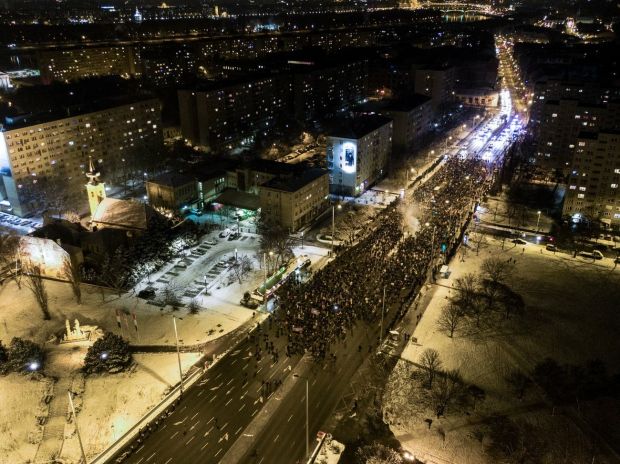Brace yourselves for a new kind of democracy, one born of a carefully managed revolution by remote control. The revolution unfolds with protest leaders from a band of the usual suspects, many of them trained abroad and with close ties to Soros networks, including minor opposition parties, a couple of dozen MPs, and a few NGOs. The protestors – pawns in a larger political game – pretend that they are the majority in the face of a two-thirds, parliamentary majority and overwhelming voter support for the governing parties.
Has the government fallen yet? No. Has the campaign for the European Parliamentary elections begun? Ohhhh, yes.
So, before anyone goes believing the international media spin and starts hyperventilating over the “thousands” demonstrating on the streets of Budapest, here are five takeaways – inconvenient truths – you should wrap your head around:
1. First, how about a photo? Here’s the crowd marching through Budapest on Sunday night. Looks like there were more people at the free-admission, Sting and Shaggy concert late last month on Heroes’ Square.

2.Then, how about some numbers? Major polling agencies say support for the governing parties has grown, not fallen. We’re talking absolute majority of voters, baby.
If Guy Verhofstadt, international “NGOs,” and the international press corps were able to vote in Hungary, then Momentum leader András Fekete-Győr would surely be prime minister today, in a coalition government with the anti-Semitic Jobbik. Fortunately for Hungary, Hungarian citizens vote – and the April elections saw the highest voter turnout since 2002 – giving the alliance of Fidesz-KDNP a two-thirds parliamentary majority. The governing alliance remains as popular as ever among Hungarian voters.
According to public opinion polling agencies, among likely voters, Fidesz-KDNP’s support ranges from 53 percent (Szazádvég and Nézőpont) to 63 (!) percent (Medián). In a distant second place, we find the far-right Jobbik mustering 11-15 percent. The Socialists have between 8 and 13 percent. Some of the other parties we see in this aggressive throng would not even pass the five percent threshold to get into parliament.
Begs the question: who has the democratic mandate here?
3. The spin doctors in the international media. Despite the government’s clear mandate and support, the media has depicted these demonstrations as some kind of Hungarian version of the French “yellow vest” movement, one report citing “around 10,000” protesting the new legislation that would put a higher limit on the possible number of overtime hours that an employer can request.
They haven’t noted, of course, that some of the opposition parties marching over the weekend were the same ones who opposed a couple of years ago the government’s proposal for Sunday closures. The international media has reported that Hungarian police used tear gas on demonstrators, but of course none of them have reported why. They’ve shown remarkable restraint in the face of acts of violence and vandalism every day from this mob. Leader of Momentum and darling of the international press, András Fekete-Győr himself threw a smoke bomb at the Hungarian police. We receive reports daily of demonstrators throwing glass, smoke bombs, beer cans, flag poles, eggs and other objects at the police, injuring at least two officers. A few days ago, the mob threatened to put fire to the large Christmas tree in front of the Hungarian Parliament – throwing fireworks and other pyrotechnic objects – after trashing the wooden sleds (and stealing some) that circled the tree.
But we’ve seen this before, I mean the international, mainstream media creating a sort of alternative reality. Recall 2015, at the peak of the migration crisis, when hundreds of thousands were crossing illegally into the EU through Hungary, it was all about human rights and the draconian response of the Orbán Government. There was no such thing, they said, as the Soros plan to bring hundreds of thousands of migrants to Europe and they pretended to never hear of foreign-funded NGOs working with human traffickers to move migrants into the EU. Nope, never happened.
4. Keeping it classy – the stomach-turning opportunism of Guy Verhofstadt. Over the weekend, the liberal leader Tweeted his support for the demonstrators, calling on them to “keep up Hungarian democracy” and closed with the truly classy “#O1G,” essentially calling the democratically elected prime minister of Hungary a g*ci. I’m not going to dignify his pedestrian name-calling by translating the word, but it’s an extremely foul Hungarian word and unbecoming of a man who likes to think of himself as some kind of European statesman.
This political creature, one of Soros’ henchmen in Brussels, never misses an opportunity that smells like it could boost his popularity with his liberal, leftist base or just be good for ‘ol Guy. Here’s a guy who served on the board of directors between 2010 and 2016 – for the tidy little fee of 60,000 EUR per year – of an offshore firm mentioned in the Paradise Papers scandal. Here’s a champion of the liberal cause who courted the Five Star Movement in Italy, then the Greens and other leftist parties, when he thought he had a chance to be elected president of the European Parliament, only to throw his weight behind Antonia Tajani, just before it was too late to abandon his own sinking ship. The reason for the ALDE leader backing the EPP candidate? Because “nationalists and populists”. Nice try, Guy.
5. No, I repeat, this is not a Hungarian version of France’s “yellow vest” movement. Opposition groups remain weak and divided, unable to produce leadership and ideas that can attract real popular support. The spectrum ranges from old Socialists to liberal Momentum to far-right, antisemitic Jobbik, and members of the press corps like HVG’s András Hont playing the role of Marianne (thanks for your objective, professional reporting from the scene, Monsieur Hont).

Recall the polling numbers I cited above, and consider for a moment what kind of results these political parties are looking forward to in the May European Parliamentary elections. There’s a smell of desperation in the air.
As I’ve said, citizens have the right to protest as long as they don’t break the law. But beware when a small minority of foreign-trained activists, representatives of losing political parties and, yes, Soros network putschists emerge hell-bent on toppling a popular, democratically elected government. Not much good can come of that.
